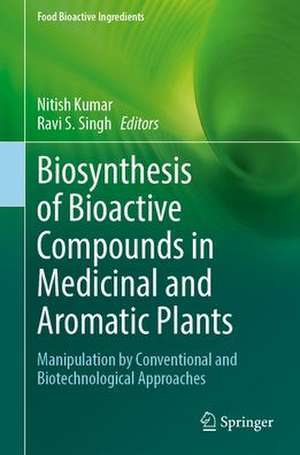Biosynthesis of Bioactive Compounds in Medicinal and Aromatic Plants: Manipulation by Conventional and Biotechnological Approaches: Food Bioactive Ingredients
Editat de Nitish Kumar, Ravi S. Singhen Limba Engleză Hardback – 12 aug 2023
Biosynthesis and Manipulation of Bioactive compounds in Medicinal and Aromatic Plants provides a comprehensive introduction and review of the state-of-the-art biotechnological tools used in enhancement of bioactive compounds in medicinal and aromatic plants. Readers will find a systematic overview of techniques such as Omics, Crisper /Cas9 and RNAi to enhance plant bioactive contents including various in vitro techniques, hairy root culture and transgenic technology to enhance plant bioactive contents using plant tissue culture approaches. The chapters provide an overview of the role of induced mutation, biotic and abiotic stress to increase the bioactive contents in plants, plus the role of endophytes to enhance the contents of plant bioactive compounds and standard operating procedures using hydroponics system of cultivation for significant enhancement of bioactive compounds.
This book serves as a single source for researchers working in plant secondary metabolites and the pharmaceutical industry.
Preț: 957.44 lei
Preț vechi: 1167.61 lei
-18% Nou
Puncte Express: 1436
Preț estimativ în valută:
183.20€ • 191.79$ • 151.59£
183.20€ • 191.79$ • 151.59£
Carte tipărită la comandă
Livrare economică 07-21 aprilie
Preluare comenzi: 021 569.72.76
Specificații
ISBN-13: 9783031352201
ISBN-10: 3031352203
Pagini: 431
Ilustrații: VIII, 431 p. 64 illus., 55 illus. in color.
Dimensiuni: 155 x 235 mm
Greutate: 0.79 kg
Ediția:1st ed. 2023
Editura: Springer Nature Switzerland
Colecția Springer
Seria Food Bioactive Ingredients
Locul publicării:Cham, Switzerland
ISBN-10: 3031352203
Pagini: 431
Ilustrații: VIII, 431 p. 64 illus., 55 illus. in color.
Dimensiuni: 155 x 235 mm
Greutate: 0.79 kg
Ediția:1st ed. 2023
Editura: Springer Nature Switzerland
Colecția Springer
Seria Food Bioactive Ingredients
Locul publicării:Cham, Switzerland
Cuprins
1. Genetic Manipulation in medicinal plants for enhancement of Plant Bioactive compounds.- 2. Exploring endophytes for in vitro synthesis of bioactive compounds in medicinal and aromatic plants.- 3. Omics approaches to study the biosynthesis of bioactive compounds in Medicinal and Aromatic Plant.- 4. Phytochemical diversity and biological activity of basil (Ocimum L.) : Secondary metabolites produced in vitro.- 5. In silico screening – An effective option in exploring Plant metabolites as Biopharmaceutics.- 6.Extreme water-stress on metabolite and elemental accumulation in Plectranthus amboinicus, an aroma-medicinal plant.- 7. RNA Interference (RNAi): A Genetic Tool to Manipulate Plant Secondary Metabolite Pathways.- 8. CRISPR/ Cas 9: Novel Techniques for Enhancing Bioactive Compound Production in Medicinal Plants.- 9. New insights for the production of medicinal plant materials: Ex vitro and in vitro propagation.- 10. Conventional approaches toward production of secondary plant metabolites.- 11. Novel secondary metabolites in tea and their biological role in communicable and non communicable human diseases.- 12. Regulation of Photochemical properties of Hawthorn: a Crataegus species.- 13. Hairy Root Cultures—A Versatile Tool of Secondary Metabolites Production.- 14. Herbosomes: An advanced delivery system for phytoconstituents.- 15. Medicinal flora of the trans Himalayan cold deserts of Ladakh, India.- 16. The medicinal potential and application of in vitro techniques in the improvement of Galega officinalis: An overview.- 17. Influence of biotic and abiotic elicitors on bioactive compounds production in medicinal plants.- 18. Aeroponic and Hydroponics system for medicinal herb.
Notă biografică
Nitish Kumar is Senior Assistant Professor at the Department of Biotechnology, Central University of South Bihar, Gaya, Bihar, India
Dr. Ravi S. Singh is an Assistant Professor in the Department of Plant Breeding and Genetics at Bihar Agricultural University, Sabour, Bihar, India
Dr. Ravi S. Singh is an Assistant Professor in the Department of Plant Breeding and Genetics at Bihar Agricultural University, Sabour, Bihar, India
Textul de pe ultima copertă
Plant bioactive compounds are plant-based natural products that display a variety of pharmacological applications. These bioactive compounds are important as medicines, pigments and flavorings since most of the pharmaceutical industries are highly dependent on medicinal plants and their extraction. The types and concentrations of bioactive compounds produced by plants are determined by the species, genotype, physiology, developmental stage and environmental factors during growth, determining the physiological adaptive responses employed by various plant taxonomic groups in coping with the stress and defensive stimuli. In the past two decades there has been a renewed interest in the study of conventional aspects such as elicitors and biotic and abiotic stress factors that influence secondary metabolism during in vitro and in vivo growth of plants. the application of molecular biology tools and techniques are facilitating increased understanding of the signaling processes and pathways involved in the bioactive compounds production in subcellular, cellular, organ and whole plant systems during in vivo and in vitro growth, with application in the metabolic engineering of biosynthetic pathways intermediates.Biosynthesis and Manipulation of Bioactive compounds in Medicinal and Aromatic Plants provides a comprehensive introduction and review of the state-of-the-art biotechnological tools used in enhancement of bioactive compounds in medicinal and aromatic plants. Readers will find a systematic overview of techniques such as Omics, Crisper /Cas9 and RNAi to enhance plant bioactive contents including various in vitro techniques, hairy root culture and transgenic technology to enhance plant bioactive contents using plant tissue culture approaches. The chapters provide an overview of the role of induced mutation, biotic and abiotic stress to increase the bioactive contents in plants, plus the role of endophytes to enhance the contents of plant bioactivecompounds and standard operating procedures using hydroponics system of cultivation for significant enhancement of bioactive compounds.
This book serves as a single source for researchers working in plant secondary metabolites and the pharmaceutical industry.
This book serves as a single source for researchers working in plant secondary metabolites and the pharmaceutical industry.
Caracteristici
Provides a review of the tools used in enhancement of bioactive compounds in medicinal and aromatic plants Presents a systematic overview of techniques such as Omics, Crisper /Cas9 and RNAi Studies the role of induced mutation, biotic and abiotic stress to increase the bioactive contents in plants









